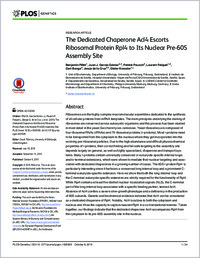The dedicated chaperone Acl4 escorts ribosomal protein Rpl4 to its nuclear pre-60S assembly site
- Pillet, Benjamin Unit of Biochemistry, Department of Biology, University of Fribourg, Switzerland
- García-Gómez, Juan J. Instituto de Biomedicina de Sevilla, Hospital Universitario Virgen del Rocío/CSIC/Universidad de Sevilla, Spain - Departamento de Genética, Universidad de Sevilla, Spain
- Pausch, Patrick LOEWE Center for Synthetic Microbiology and Department of Chemistry, Philipps-University Marburg, Germany
- Falquet, Laurent Unit of Biochemistry, Department of Biology, University of Fribourg, Switzerland - Swiss Institute of Bioinformatics, University of Fribourg, Switzerland
- Bange, Gert LOEWE Center for Synthetic Microbiology and Department of Chemistry, Philipps-University Marburg, Germany
- Cruz, Jesús de la Instituto de Biomedicina de Sevilla, Hospital Universitario Virgen del Rocío/CSIC/Universidad de Sevilla, Spain - Departamento de Genética, Universidad de Sevilla, Spain
- Kressler, Dieter Unit of Biochemistry, Department of Biology, University of Fribourg, Switzerland
-
08.10.2015
Published in:
- PLoS Genet. - 2015, vol. 11, no. 10, p. e1005565
English
Ribosomes are the highly complex macromolecular assemblies dedicated to the synthesis of all cellular proteins from mRNA templates. The main principles underlying the making of ribosomes are conserved across eukaryotic organisms and this process has been studied in most detail in the yeast Saccharomyces cerevisiae. Yeast ribosomes are composed of four ribosomal RNAs (rRNAs) and 79 ribosomal proteins (r-proteins). Most r-proteins need to be transported from the cytoplasm to the nucleus where they get incorporated into the evolving pre-ribosomal particles. Due to the high abundance and difficult physicochemical properties of r-proteins, their correct folding and fail-safe targeting to the assembly site depends largely on general, as well as highly specialized, chaperone and transport systems. Many r-proteins contain universally conserved or eukaryote-specific internal loops and/or terminal extensions, which were shown to mediate their nuclear targeting and association with dedicated chaperones in a growing number of cases. The 60S r-protein Rpl4 is particularly interesting since it harbours a conserved long internal loop and a prominent C-terminal eukaryote-specific extension. Here we show that both the long internal loop and the C-terminal eukaryote-specific extension are strictly required for the functionality of Rpl4. While Rpl4 contains at least five distinct nuclear localization signals (NLS), the C-terminal part of the long internal loop associates with a specific binding partner, termed Acl4. Absence of Acl4 confers a severe slow-growth phenotype and a deficiency in the production of 60S subunits. Genetic and biochemical evidence indicates that Acl4 can be considered as a dedicated chaperone of Rpl4. Notably, Acl4 localizes to both the cytoplasm and nucleus and it has the capacity to capture nascent Rpl4 in a co-translational manner. Taken together, our findings indicate that the dedicated chaperone Acl4 accompanies Rpl4 from the cytoplasm to its pre-60S assembly site in the nucleus.
- Faculty
- Faculté des sciences et de médecine
- Department
- Département de Biologie
- Language
-
- English
- Classification
- Biological sciences
- License
-
License undefined
- Identifiers
-
- RERO DOC 257832
- DOI 10.1371/journal.pgen.1005565
- Persistent URL
- https://folia.unifr.ch/unifr/documents/304556
Statistics
Document views: 123
File downloads:
- pdf: 147
